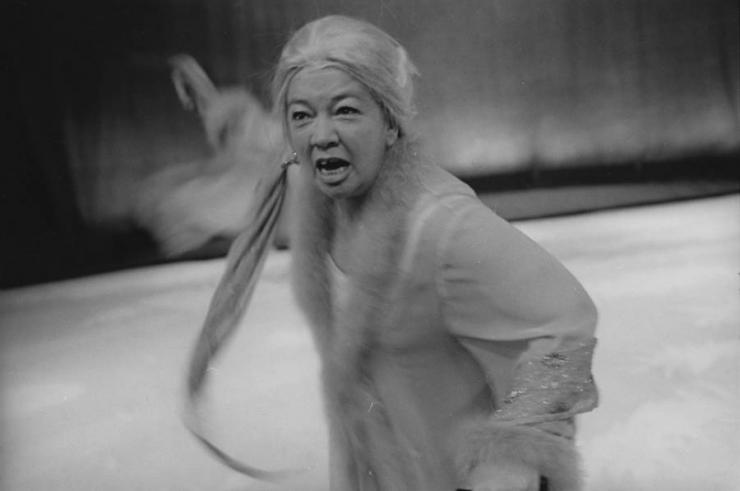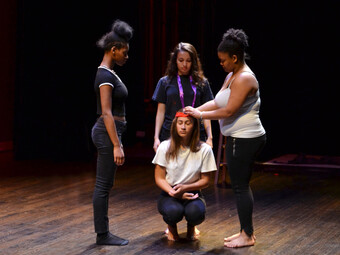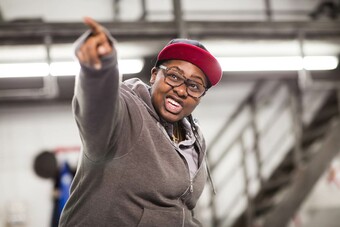He That Plays The King
King Lear is a masterpiece. Jan Kott said that next to Lear, “even Macbeth and Hamlet seem tame and pedestrian.” Harold Bloom dared call it “the height of literary experience,” a play so inexorably tragic that from 1681 to 1838 the English stage settled for a rewrite by Nahum Tate that absconded with its bleak finale. I count myself as a devotee. So much so that I found myself less than a week ago in a movie-house watching a rare screening of Akira Kurosawa’s Ran—his Lear adaptation set in Feudal Japan. I thought, “How well does the ageless might of Shakespeare translate for other cultures, races, and eras!”
I’ve been in Lear three times, once with my colleague and friend Hailey Bachrach. She played Cordelia, and detailed her experience. She describes the debasement of going from a Character to a Body. Carried onstage, literally helpless to play anything other than victimization, and to fuel the journey of the male lead.
Circa 2006 Robert Falls’ production of Lear hit Chicago’s Goodman Theatre with a grisly thunk. Stacey Keach played the King of a Briton-by-way-of-Yugoslavia for the twenty-first century. When I saw the production in DC, no one could deny the guts of Falls’ violent, nihilistic take. And it worked for me, until the agonized Lear staggers on in the climax with the body of his daughter—a battered, naked body. More than a victim of tragedy, a victim of explicitly gendered tragedy.
Shakespeare’s lushly unreal worlds, vaunting historical fact in favor of commonality, give us what few playwrights have been able to provide: freedom of interpretation.
Shakespeare does not see the female body the way we see them today. He was perhaps not writing plays for bodies at all, but for voices. Though they saw them too, a Shakespearean audience went to “hear a play” (as Hamlet says). Characters were not objects but vessels for ideas. It’s the same paradox that was true of Ancient Greek theatre. The sexism that prevented women from playing Medea was the midwife of Medea’s three-dimensional characterization. A strong female role was written in part because a man had to play it.
But more than that, Shakespeare’s lushly unreal worlds, vaunting historical fact in favor of commonality, give us what few playwrights have been able to provide: freedom of interpretation.
In his play Equivocation, Bill Cain puts it nicely. Here, Robert Cecil explains why he has commissioned “Shagspeare” to write an important play—and not anyone else.
CECIL: Of all the writers now writing, your work will last. I knew that after your play about the Moor. You took a very bold position. You told the Moors they are noble victims of a cruel white world. Then you had the Moor disembowel himself for the entertainment of the white audience—and everyone—even the Moors—were pleased. You did the same thing with the Jews. […] You have discovered what every leader from Jesus to James has sought in vain. You, Master Shagspeare, have discovered how to be all things to all men.
But maybe not to all women. UK Director Katie Mitchell talked to The Pool, calling Shakespeare’s gender politics “execrable.” She further notes, “I find Hamlet offensive from a gender point of view. There is something about the celebration of a depressed, violent man in the play which I am a bit weary of.” Mitchell’s collaboration with playwright Alice Birch, Ophelias Zimmer (developed first at the Schaubühne in Berlin, lately the Royal Court), sees Hamlet from Ophelia’s perspective.
An actress once told me flatly that, though she loved Shakespeare, she “didn’t ever need to see” some plays that understandably jangled her feminist nerves—Taming of the Shrew topped the list. And a decision like hers or Mitchell’s deserves respect. They’re not wrong. But the success of Shakespeare as a playwright and, intentionally or not, as an ally, is that Ms. Mitchell and I can disagree about his texts, and both be right. I’ve seen Taming of the Shrew presented in such a way that I was convinced it was a kind of feminist Trojan Horse. And I’ve seen Hamlet as the story of a depressed, violent…woman.
We are presently in a national dialogue about casting inclusivity. What used to be “color-blind” casting has become “color-conscious.” Thus goes the line between gender-blind and gender-conscious casting. Should a production flip an Iago or Hamlet chromosomally, that’s news.

Some say the leftist way is altering the text to reimagine, swapping pronouns and pants for petticoats. Phyllida Lloyd’s all-female Julius Caesar and Henry IV make ripples about gender by framing Shakespeare with the bars of a women’s prison. In the ’90s, Mabou Mines cast Ruth Maleczech as a remodeled Queen Lear in a headline-making “reimagining.”
Others are happy to leave the plays in a world where gender is fluid—as if setting the text in the kind of post-equality utopia we’re all striving for. Sarah Bernhardt and Charlotte Cushman played Hamlet in drag, nary a pronoun altered—and some productions strip away the conceit of gender, adherent to text and helter-skelter with casting.
Shakespeare is one of the only playwrights treated this way. Look no further than the recent groundswell about mega-hit Hamilton “potentially” gender-swapping prominent male roles for its touring production. Reactions to the news remind us that the situation is practically unheard-of. Often, this comes down to rights and estates (see: Beckett and Mamet), but the attempt has never caught on in Chekhov, Ibsen, Strindberg, Molière, and even (generally) in the Greeks. What did Shakespeare do that no one else fully did?
When it comes to writing women, the lesson we draw is to write without judgment and busy ourselves with the creation of stories that will not hiss and shrink back when looked at through different lenses.
The first time I was in Lear, there was no Stacey Keach in the howling title role, not one of the Lears of Yore like Sir Anthony Sher or Paul Scofield, nor a windswept Tatsuya Nakadai (who played it in Ran), or not even a Ruth Maleczech. It was in a small, sweltering Black Box in Northern Virginia, and Lear was a twentysomething African-American woman. And she was electric. No makeup, no realism. The words were hers.
Shakespeare spoke to every era that followed him, even if they did warp and warble his words to fit their lives, as Nahum Tate did or Lee Breuer when reworking Queen Lear. When it comes to writing women, the lesson we draw is to write without judgment and busy ourselves with the creation of stories that will not hiss and shrink back when looked at through different lenses. As so many of us were quietly inveigled to see The Straight White Man as Universal, we can strive as Shakespeare did to, with the energy of storytelling, reshape universality onstage as it is being reshaped in our world.
So, in the end we’ve barely scratched the surface. What were Shakespeare’s triumphs, his failures? Shakespeare will always be. What’s imperative for us it that we look to the universality of his work.
The new question is this: what writers are doing this today? How do we do this? Should we do this at all? Is it our responsibility to create, in our characters, blank canvases for human experience? Or is that too over-simple, merely a way of sidestepping specificity and intentionality? Is the test of a good play that it can be for and about anyone, and that its lens can be constantly re-focused without ever losing the light?
Not all stories are universal, of course, nor should they be. Next we’ll look at what happens when Western theatre started to narrow its focus—and when men started writing female roles for women.









Comments
The article is just the start of the conversation—we want to know what you think about this subject, too! HowlRound is a space for knowledge-sharing, and we welcome spirited, thoughtful, and on-topic dialogue. Find our full comments policy here